AMPKα1/2 (phospho Thr183/172) Polyclonal Antibody
- Catalog No.:YP0575
- Applications:IF;WB;IHC;ELISA
- Reactivity:Human;Mouse;Rat;Monkey;Pig;Marsupenaeus japonicus
- Target:
- AMPKα1/2
- Fields:
- >>FoxO signaling pathway;>>Autophagy - animal;>>mTOR signaling pathway;>>PI3K-Akt signaling pathway;>>AMPK signaling pathway;>>Longevity regulating pathway;>>Longevity regulating pathway - multiple species;>>Apelin signaling pathway;>>Tight junction;>>Circadian rhythm;>>Thermogenesis;>>Insulin signaling pathway;>>Adipocytokine signaling pathway;>>Oxytocin signaling pathway;>>Glucagon signaling pathway;>>Insulin resistance;>>Non-alcoholic fatty liver disease;>>Alcoholic liver disease;>>Hypertrophic cardiomyopathy;>>Fluid shear stress and atherosclerosis
- Gene Name:
- AAPK1/AAPK2
- Protein Name:
- 5'-AMP-activated protein kinase catalytic subunit alpha-1/2
- Human Gene Id:
- 5562/5563
- Human Swiss Prot No:
- Q13131/P54646
- Mouse Gene Id:
- 105787/108079
- Rat Gene Id:
- 65248/78975
- Rat Swiss Prot No:
- P54645/Q09137
- Immunogen:
- The antiserum was produced against synthesized peptide derived from human AMPK alpha around the phosphorylation site of Thr172. AA range:140-189
- Specificity:
- Phospho-AMPKα1/2 (T183/172) Polyclonal Antibody detects endogenous levels of AMPKα1/2 protein only when phosphorylated at T183/172.
- Formulation:
- Liquid in PBS containing 50% glycerol, 0.5% BSA and 0.02% sodium azide.
- Source:
- Polyclonal, Rabbit,IgG
- Dilution:
- IF 1:50-200 WB 1:500 - 1:2000. IHC 1:100 - 1:300. ELISA: 1:40000. Not yet tested in other applications.
- Purification:
- The antibody was affinity-purified from rabbit antiserum by affinity-chromatography using epitope-specific immunogen.
- Concentration:
- 1 mg/ml
- Storage Stability:
- -15°C to -25°C/1 year(Do not lower than -25°C)
- Other Name:
- PRKAA1;AMPK1;5'-AMP-activated protein kinase catalytic subunit alpha-1;AMPK subunit alpha-1;Acetyl-CoA carboxylase kinase;ACACA kinase;Hydroxymethylglutaryl-CoA reductase kinase;HMGCR kinase;Tau-protein kinase PRKAA1;PRKAA2;AMPK;
- Observed Band(KD):
- 63kD
- Background:
- The protein encoded by this gene belongs to the ser/thr protein kinase family. It is the catalytic subunit of the 5'-prime-AMP-activated protein kinase (AMPK). AMPK is a cellular energy sensor conserved in all eukaryotic cells. The kinase activity of AMPK is activated by the stimuli that increase the cellular AMP/ATP ratio. AMPK regulates the activities of a number of key metabolic enzymes through phosphorylation. It protects cells from stresses that cause ATP depletion by switching off ATP-consuming biosynthetic pathways. Alternatively spliced transcript variants encoding distinct isoforms have been observed. [provided by RefSeq, Jul 2008],
- Function:
- catalytic activity:ATP + a protein = ADP + a phosphoprotein.,cofactor:Magnesium.,enzyme regulation:Binding of AMP results in allosteric activation, inducing phosphorylation on Thr-174 by STK11 in complex with STE20-related adapter-alpha (STRAD alpha) pseudo kinase and CAB39. Also activated by phosphorylation by CAMKK2 triggered by a rise in intracellular calcium ions, without detectable changes in the AMP/ATP ratio.,function:Responsible for the regulation of fatty acid synthesis by phosphorylation of acetyl-CoA carboxylase. It also regulates cholesterol synthesis via phosphorylation and inactivation of hormone-sensitive lipase and hydroxymethylglutaryl-CoA reductase. Appears to act as a metabolic stress-sensing protein kinase switching off biosynthetic pathways when cellular ATP levels are depleted and when 5'-AMP rises in response to fuel limitation and/or hypoxia. This is a catalytic s
- Subcellular Location:
- Cytoplasm . Nucleus . In response to stress, recruited by p53/TP53 to specific promoters. .
- Expression:
- Brain,Intestine,Liver,Mammary gland,Platelet,Testis
Liver-target nanotechnology facilitates berberine to ameliorate cardio-metabolic diseases. Nature Communications Nat Commun. 2019 Apr;10(1):1-16 IF Mouse,Human 1:100 liver tissue hepG2 cell
TNAP inhibition attenuates cardiac fibrosis induced by myocardial infarction through deactivating TGF-β1/Smads and activating P53 signaling pathways. Cell Death & Disease Cell Death Dis. 2020 Jan;11(1):1-15 WB Rat heart
Autophagy and apoptosis mediated nano-copper-induced testicular damage. ECOTOXICOLOGY AND ENVIRONMENTAL SAFETY Ecotox Environ Safe. 2022 Jan;229:113039 WB Rat Testis
Bawei Chenxiang Wan Ameliorates Cardiac Hypertrophy by Activating AMPK/PPAR-α Signaling Pathway Improving Energy Metabolism. Frontiers in Pharmacology Front Pharmacol. 2021 Jun;0:1314 WB Rat Myocardial tissue
SIRT3 deficiency is resistant to autophagy‐dependent ferroptosis by inhibiting the AMPK/mTOR pathway and promoting GPX4 levels. JOURNAL OF CELLULAR PHYSIOLOGY J Cell Physiol. 2020 Nov;235(11):8839-8851 WB Human 1:2000 HTR8/SVeno cell
p53 Mediates Colistin-Induced Autophagy and Apoptosis in PC-12 Cells. ANTIMICROBIAL AGENTS AND CHEMOTHERAPY Antimicrob Agents Ch. 2016 Sep;60(9):5294-5301 WB Rat 1:1000 PC-12 cell
Dl-3-n-Butylphthalide Promotes Remyelination and Suppresses Inflammation by Regulating AMPK/SIRT1 and STAT3/NF-κB Signaling in Chronic Cerebral Hypoperfusion. Frontiers in Aging Neuroscience Front Aging Neurosci. 2020 Jun;0:137 WB Rat 1:1000 White matter
Effect of metformin on apoptosis, cell cycle arrest migration and invasion of A498 cells. Molecular Medicine Reports 2014 Mar 31 WB Human A498 cell
Outer membrane protein a in Acinetobacter baumannii induces autophagy through mTOR signalling pathways in the lung of SD rats. BIOMEDICINE & PHARMACOTHERAPY Biomed Pharmacother. 2021 Mar;135:111034 IF,IHC,WB Rat 1:100,1: 500,1:100 Lung WTRL1 cell
Autophagy was activated against the damages of placentas caused by nano-copper oral exposure. ECOTOXICOLOGY AND ENVIRONMENTAL SAFETY Ecotox Environ Safe. 2021 Sep;220:112364 WB Rat 1:1000 Placentas
Metformin ameliorates bladder dysfunction in a rat model of partial bladder outlet obstruction. AMERICAN JOURNAL OF PHYSIOLOGY-RENAL PHYSIOLOGY Am J Physiol-Renal. 2021 Mar;(Articles in Press): WB,IF,IHC Rat 1 : 400,1:1000 Bladder tissues BSMCs
Short communication: Relationship between lysine/methionine ratios and glucose levels and their effects on casein synthesis via activation of the mechanistic target of rapamycin signaling pathway in bovine mammary epithelial cells. JOURNAL OF DAIRY SCIENCE 2019 Jul 17 WB Bovine mammary epithelial cell
d-Glucose and amino acid deficiency inhibits casein synthesis through JAK2/STAT5 and AMPK/mTOR signaling pathways in mammary epithelial cells of dairy cows. JOURNAL OF DAIRY SCIENCE J Dairy Sci. 2018 Feb;101:1737 WB Bovine cow mammary epithelial cells (CMEC)
Overexpression of ATG4a promotes autophagy and proliferation, and inhibits apoptosis in lens epithelial cells via the AMPK and Akt pathways. Molecular Medicine Reports Mol Med Rep. 2020 Aug;22(2):1295-1302 WB Human 1 : 1000 Lens epithelial cells
Jiazi, Dong, et al. "Effects of electroacupuncture at Zusanli (ST36) on AMPK-mitochondria pathway in cardiac cells of rats with spleen deficiency." Journal of Beijing University of Traditional Chinese Medicine 43.6 (2020).
Bawei Chenxiang Wan Ameliorates Cardiac Hypertrophy by Activating AMPK/PPAR-α Signaling Pathway Improving Energy Metabolism. Frontiers in Pharmacology Front Pharmacol. 2021 Jun;0:1314 WB Rat Myocardial tissue
Enhancement of BCAT2-Mediated Valine Catabolism Stimulates β-Casein Synthesis via the AMPK-mTOR Signaling Axis in Bovine Mammary Epithelial Cells JOURNAL OF AGRICULTURAL AND FOOD CHEMISTRY Zhaoyu Han WB Bovine
The role of AMPK-Sirt1-autophagy pathway in the intestinal protection process by propofol against regional ischemia/reperfusion injury in rats INTERNATIONAL IMMUNOPHARMACOLOGY Mao-Hua Wang IF Rat
WSSV exploits AMPK to activate mTORC2 signaling for proliferation by enhancing aerobic glycolysis Communications Biology Jin-Xing Wang WB,IHC Marsupenaeus japonicus heart,hepatopancreas,gills,stomach,intestines hemocytes
New fungal protein from Pleurotus ferulae lanzi induces AMPK-mediated autophagy and G1-phase cell cycle arrest in A549 lung cancer cells. Zhao-Kun Liu WB,IHC Mouse,Human 1:500,1:150 A549 cell-Xenograft A549 cell
ZEA mediates autophagy through the ROS-AMPK-m-TOR pathway to enhance the susceptibility of mastitis induced by Staphylococcus aureus in mice. ECOTOXICOLOGY AND ENVIRONMENTAL SAFETY Xiaoyu Hu WB Mouse mouse mammary epithelial cells (MMEC)
Blockage of EGFR/AKT and mevalonate pathways synergize the antitumor effect of temozolomide by reprogramming energy metabolism in glioblastoma Cancer Communications Xiaoteng Cui WB Human 1:500 TBD0220 cell,U-87 MG cell
Jiangqi Pingxiao formula regulates dendritic cell apoptosis in an autophagy-dependent manner through the AMPK/mTOR pathway in a murine model of OVA-induced asthma JOURNAL OF ETHNOPHARMACOLOGY Yiwen Shan WB Mouse 1:1000 bone marrow dendritic cells (BMDC)
- June 19-2018
- WESTERN IMMUNOBLOTTING PROTOCOL
- June 19-2018
- IMMUNOHISTOCHEMISTRY-PARAFFIN PROTOCOL
- June 19-2018
- IMMUNOFLUORESCENCE PROTOCOL
- September 08-2020
- FLOW-CYTOMEYRT-PROTOCOL
- May 20-2022
- Cell-Based ELISA│解您多样本WB检测之困扰
- July 13-2018
- CELL-BASED-ELISA-PROTOCOL-FOR-ACETYL-PROTEIN
- July 13-2018
- CELL-BASED-ELISA-PROTOCOL-FOR-PHOSPHO-PROTEIN
- July 13-2018
- Antibody-FAQs
- Products Images
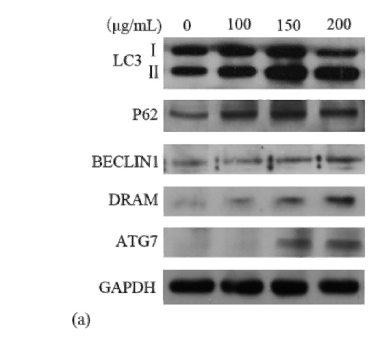
- New fungal protein from Pleurotus ferulae lanzi induces AMPK-mediated autophagy and G1-phase cell cycle arrest in A549 lung cancer cells. Zhao-Kun Liu WB Human 1:250 A549 cell
.png)
- Kang, Min, et al. "Autophagy was activated against the damages of placentas caused by nano-copper oral exposure." Ecotoxicology and Environmental Safety 220 (2021): 112364.
.png)
- Gao, L., Wang, Ly., Liu, Zq. et al. TNAP inhibition attenuates cardiac fibrosis induced by myocardial infarction through deactivating TGF-β1/Smads and activating P53 signaling pathways. Cell Death Dis 11, 44 (2020)

- Guo, Hui-Hui, et al. "Liver-target nanotechnology facilitates berberine to ameliorate cardio-metabolic diseases." Nature communications 10.1 (2019): 1981.
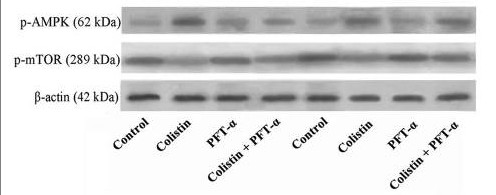
- Zhang, Ling, et al. "P53 mediates colistin-induced autophagy and apoptosis in PC-12 cells." Antimicrobial agents and chemotherapy (2016): AAC-00641.

- Min, Qing-Qing, et al. "Effects of Metformin Combined with Lactoferrin on Lipid Accumulation and Metabolism in Mice Fed with High-Fat Diet." Nutrients 10.11 (2018): 1628.

- Immunofluorescence analysis of Hela cell. 1,AMPKα1/2 (phospho Thr183/172) Polyclonal Antibody(green) was diluted at 1:200(4° overnight). (red) was diluted at 1:200(4° overnight). 2, Goat Anti Rabbit Alexa Fluor 488 Catalog:RS3211 was diluted at 1:1000(room temperature, 50min). Goat Anti Mouse Alexa Fluor 594 Catalog:RS3608 was diluted at 1:1000(room temperature, 50min).
-if-118.jpg)
- Immunofluorescence analysis of rat-heart tissue. 1,AMPKα1/2 (phospho Thr183/172) Polyclonal Antibody(red) was diluted at 1:200(4°C,overnight). 2, Cy3 labled Secondary antibody was diluted at 1:300(room temperature, 50min).3, Picture B: DAPI(blue) 10min. Picture A:Target. Picture B: DAPI. Picture C: merge of A+B
2016-12-1.jpg)
- Western Blot analysis of mouse-lung cells using primary antibody diluted at 1:1000(4°C overnight). Secondary antibody:Goat Anti-rabbit IgG IRDye 800( diluted at 1:5000, 25°C, 1 hour). Cell lysate was extracted by Minute™ Plasma Membrane Protein Isolation and Cell Fractionation Kit(SM-005, Inventbiotech,MN,USA).
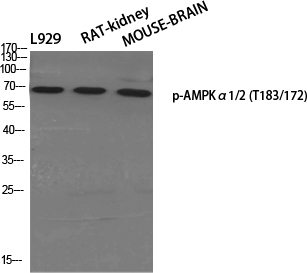
- Western Blot analysis of various cells using Phospho-AMPKα1/2 (T183/172) Polyclonal Antibody diluted at 1:500
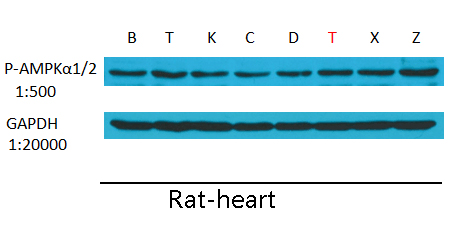
- The picture was kindly provided by our customer

- The picture was kindly provided by our customer
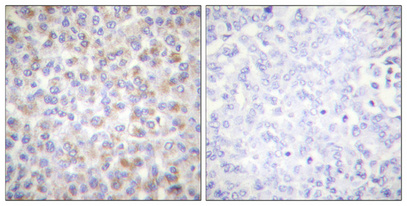
- Immunohistochemical analysis of paraffin-embedded Human breast cancer. Antibody was diluted at 1:100(4° overnight). High-pressure and temperature Tris-EDTA,pH8.0 was used for antigen retrieval. Negetive contrl (right) obtaned from antibody was pre-absorbed by immunogen peptide.
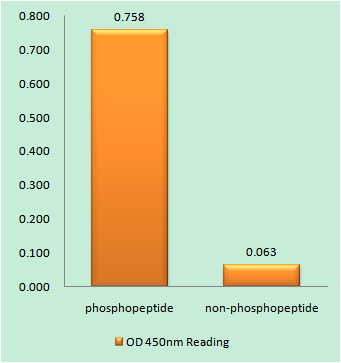
- Enzyme-Linked Immunosorbent Assay (Phospho-ELISA) for Immunogen Phosphopeptide (Phospho-left) and Non-Phosphopeptide (Phospho-right), using AMPK alpha (Phospho-Thr172) Antibody

- Immunohistochemistry analysis of paraffin-embedded human breast carcinoma, using AMPK alpha (Phospho-Thr172) Antibody. The picture on the right is blocked with the phospho peptide.



